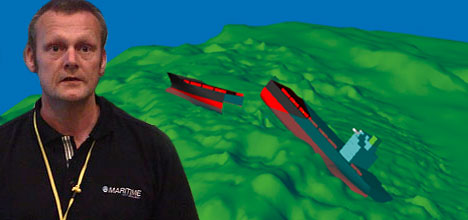A comprehensive sonar mapping programme covering the Astrolabe Reef and surrounding seafloor is necessary before the Rena salvage operation can continue.
Maritime New Zealand salvage unit manager David Billington says the seafloor has to be mapped to find all the lost containers, hatch covers and other scattered wreckage.
MNZ salvage unit manager David Billington says sonar mapping of the Astrolabe Reef and Rena wreck needs to be conducted before salvors can safely resume lifting containers from the broken vessel.
That task has to be completed before the Smit Borneo crane barge is returned to the Rena wreck to lift containers from the bow section that remains on the reef.
MNZ is not rushing to give time for both the wreck and the weather to settle.
The aft two thirds of the 236m long container ship are lying on the slope of the reef with the forward end clear of the water. At high tide its accommodation section is totally submerged.
In a brief address to a meeting of about 25 of Tauranga's commercial marine operators today, David presented a brief timeline of the stern section's sinking on Tuesday.
Rena was broken in two during rough weather over the weekend. Shortly after the dawn overflight on Tuesday, motion sensors onboard the stern section warned of movement.
The anchor tug Go Canopus made an attempt to tow the aft two thirds of the ship around, to make it easier for the recovery barge to get closer to the ship when operations resumed.
'I was like trying to ask a little boy to pull an elephant round the garden,” says David.
Go Canopus has a bollard pull of 149 tonnes, but it had no show against the mass of Rena's water filled stern section, says David.
The hatch covers were blown off because the bottom of the ship was ripped out in the initial collision with the reef.
As it sank, pressure from containers floating up in the holds blew the covers clear, says David. The 20-30 tonne hatch covers will not float.
A helicopter with Svitzer personnel landed on the bow section of the Rena at 9.20am to monitor the condition of the stern, which progressively sank between 9.30am and 10am.
A small amount of oil and debris, and two containers were discharged from the stern section as it submerged.
The life rafts that deployed when the stern section sank had been left onboard as a safety measure during salvage operations.
'It was always known that at some stage a similar event was likely,” says David.
We left the safety equipment onboard, so that if there are people onboard they can get off if needs be.
'Svitzer was planning on putting people on the stern section that morning.”
For now the ship and the weather will have to settle before further steps are taken.
'Once they have done the mapping and we find out what's on the seabed, we will consider putting the Smit Borneo back in position and start trying to think about getting containers off.”



2 comments
Series of unfortunate events
Posted on 11-01-2012 17:09 | By MINDER
Why salvage MV RENA now let it rot - time was the salvors enemy and they lost that battle after fiddling around for 3 months or so.
MINDER
Posted on 12-01-2012 07:14 | By whatsinaname
You no how long it will take for a ship to rot......Its not as simple as going on board Rena and doing what they did. I commend them on the job they have done so far. sea conditions at the Astrolabe are not always favourable.
Leave a Comment
You must be logged in to make a comment.